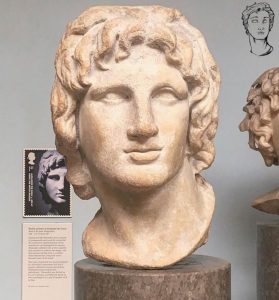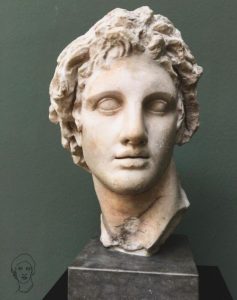Thinking about antiquity, there can be no one more iconic and famous than Alexander the Great. Even though he died at a very young age, he managed to create one of the biggest empires seen to this day. His conquests of the east were defining for the Hellenistic period as it allowed Greek culture to spread through the non‑Greek world. He has inspired many people and it is no surprise that there are several depictions of Alexander in musea all over the world. So what does this brilliant military leader look like? Are there a lot of differences? Who was allowed to portray him? Read on to find out more!
Herm of Alexander the Great, Louvre

This herm is easy to identify as Alexander the Great because of the inscription found underneath the head, which reads: “Alexander, (son of) Philip, (king of) Macedon”. Dating first or second century AD, this Herm is a copy of a bronze statue made by the sculptor Lysippos around 330 BC.
According to ancient literary sources Alexander only chose a few artists to produce his image, such as the sculptor Lysippos and the painter Apelles. The originals do not survive, but a variety of copies in different materials survive!
Head of Alexander, Acropolis Museum

It is believed to haven been made between 340 and 330 BC, right in the middle of Alexander’s conquests. The work is most likely an original of the sculptor Leochares, which is interesting because normally official images depicting Alexander were made by the sculptor Lysippos.
Head of Alexander, British Museum

A bust of Alexander the Great, this one is from the 2nd or 1st century and probably made in Alexandria. During his lifetime, Alexander strictly controlled the ways in which he was depicted. He had only a few sculptors who were allowed make sculptors of him and portrayed him in the typical youthful manner: with clean‑shaven face, long hair and a dynamic turn of the head.
Head of Alexander the Great, Glyptoteket
 This bust of Alexander the Great, found in Alexandria made from marble, dated to 3rd century BC. Alexander was shown without a beard, which was something new: all previous portraits of Greek statesmen or rulers had beards. This fashion lasted for five hundred years and almost all of the Hellenistic kings and Roman emperors until Hadrian were portrayed beardless.
This bust of Alexander the Great, found in Alexandria made from marble, dated to 3rd century BC. Alexander was shown without a beard, which was something new: all previous portraits of Greek statesmen or rulers had beards. This fashion lasted for five hundred years and almost all of the Hellenistic kings and Roman emperors until Hadrian were portrayed beardless.
Head of Alexander the Great, Istanbul

This is the bust of Alexander the Great at the Archaeological Museum of Istanbul. Originally the head comes from Pergamon and is dated to the first half of the second century BC. Portraits from before Alexander’s death, his portraits tended to be more mature and realistic, while the posthumous ones show a more youthful, though perhaps more god‑like character. He has longer hair, a more dynamic tilt of the head and an upward gaze, resembling his description in literary sources.
Head of Alexander, Louvre

Head of Alexander?, Agora

This is head of a young man comes from the second century AD. It is an unfinished copy of an original from the fourth century BC. Experts have identified the individual either as a young Alexander the Great or the god Eubolos, who was connected to the Eleusinian Mysteries
Alexander with lion’s skin, Athens

He is wearing a lion’s pelt, creating a link with the mythical hero Herakles who wears the lion pelt after he slew the Nemean lion. You can see an image of Heracles with lion skin on the obverse of many of Alexander’s coins.
The head was found in the potter’s quarter of Kerameikos in Athens and dates to around 330 BC. The letters carved on Alexander’s cheeks were added at a later date.
Alexander coin showing Herakles

These marble heads are beautiful, but the most common image of Alexander is featured on his coins. However, the picture most people associate with Alexander is actually the head of Herakles right, wearing lionskin headdress, as seen on this coin. The reverse shows the inscription AΛEXANΔΡOY, Zeus seated left, holding eagle and sceptre.
Head of Alexander, tetradrachm of Lysimachos

The head of Alexander the Great only shows on coins made by his successors. He always has the horns of Zeus Ammon, which refer to Alexander’s claim to be the son of the Egyptian god Ammon.
Silver tetradrachm of Lysimachos

The coin shows the diademed head of deified Alexander right, wearing horn of Ammon on the obverse and revers depicts Athena Nikephoros seated left, holding Nike in extended right hand, left arm resting on shield surrounded by the inscription BAΣIΛEΩΣ ΛYΣIMAXOY.
Alexander mosaic, house of the Faun

A third kind of image of Alexander is the so‑called Alexander mosaicThis mosaic was created around 100 BC and was found in the House of the Faun at Pompeii. The whole mosaic is around 2 meters wide and used more then 1.5 million tesserae. It shows a battle between the armies of Alexander the Great and Darius III, traditionally believed to be the battle of the Issus in 333 BC. The mosaic is thought to be a copy of a Hellenistic painting.
It certainly follows the Greek tradition of depicting close up portraits of heroes in battle. Alexander is posed in action while killing a man with his spear. He is wearing a breastplate with Medusa’s head on it and is riding his horse Bulcephalus.
Which one of these marble heads have you seen? Can you see any similarities with the coins? What about the mosaic? Have any comments? Get in touch!




